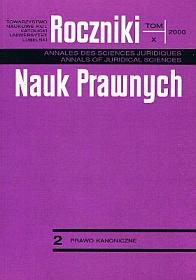Misyjność Kościoła powszechnego w aspekcie historycznym i prawnym - definicja misji „ad gentes”
Abstrakt
The Church's missionary activities are still topical. At present they have been given a direction by Pope John Paul II who at the same time in his speeches and papal documents stressed his spiritual unity with his predecessors who cared about missions. The whole paper is an attempt at presenting the missionary character of the Catholic Church and the organization of the missionary activity in the historical and legal aspects. The latter aspect is better seen as we base our considerations on the Council documents and on the legal norms of John Paul II's code. The paper also takes a historical approach, devoid of significant contemporary analyses, although some of them are mentioned. We suggest that problems connected with missions should be reminded, so that the source of the Church's existence in the millenium about to end, could be seen and so that the Catholic Church could revive and become more alive within the consciousness of its missionary essence. The Church, sent by Christ to peoples and nations, obedient to His missionary call “Go and teach all nations”, in an incessant, constant way gives testimony as far as the limits of the world. The article discusses the legal sources, the notion of "missions”: it shows a number of definitions of missions worked out by various authors, especially by missiologists, and it quotes the definition of mission given by the Vatican Council II. The main legal source of the Church's missionary activities is God Himself who sends the Son to the world so that He could redeem it. Christ, in turn, sends the Holy Spirit. In this sending we can see vitality and energy so that the Church could live and reach all the continents and embrace all the people of good will with God’s love, people for whom God has taken a liking in the Third Millennium of Christianity. Beyond the threshold of that Millennium we can expect a new dawning of faith and Christian life among confessors of Christ.
The basic parts of the paper are: 1. introduction, where we point to legitimacy of the subject taken up here: we show that there is a necessity to speak about missions to contemporary Christians and also to point that on the strength of Baptism and Confirmation, the sacraments of Christian initiation, everybody is responsible for missions and everybody is called by Christ to perform this mission; 2. explanation of the notion of "missions” and its legal sources. The historical context is shown of the origin of missions and it is said on what grounds the Church has the right and duty to continue Christ's mission; 3. the next paragraph acquaints the reader with the teaching of some popes in a historical approach, taking into consideration what was characteristic of the given pope. It is also an attempt at showing the historical organization of missions; 4. next, suggestions for the Council and missions before the Council are discussed. It appears that the Church did well, as it invited hierarchs and monastic superiors to send in suggestions and prepositions for the Council, which they did. As result of these activities and proceedings in the Council aula the decree about missions entitled Ad gentes was worked out: 5. in the final paragraph the Council’s teaching about missions is presented. It is the wealth of the Council’s teaching and of the wisdom of the Fathers of the Council who, gifted with a plenitude of charisma by God, recognized a new image of the Church in the new understanding of missions and evangelization.
Copyright (c) 2000 Roczniki Nauk Prawnych

Utwór dostępny jest na licencji Creative Commons Uznanie autorstwa – Użycie niekomercyjne – Bez utworów zależnych 4.0 Międzynarodowe.


